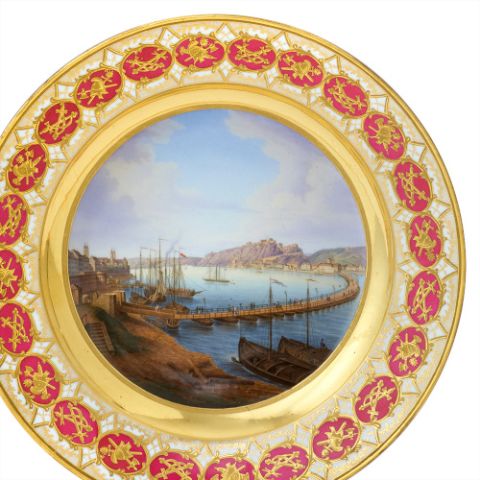
Lot closed
Lot 566 | France | TABLE WITH UNUSUAL INLAYS
Estimate
3.000
- 4.000
€
D ‡
Result
Unsold
TABLE WITH UNUSUAL INLAYS.
France.
Date: Table top 18th c., the frame around 1800.
Technique: Boulle technique with fine brass inlays.
Description: The table with four flat, sweeping C-shaped legs set in an octagonal nodus. A
baluster-shaped shaft above, supporting the wide, rectangular table top. The table top
features extremely fine and complex tortoiseshell and brass inlays with engraved details.
In the center, three console-like pedestals with three dancing cupids and, flanking them,
two horsemen with feather decorations, each under exotic canopy architecture. Along the
edges a wide band with grotesques, mythical creatures and mascarons, between them festoons
with cupids.
Measurement: 73,5x100x63cm.
Some of the brass inlays loose and lost.
Literature:
Kjellberg, Pierre Le Mobilier Français Du XVIII Siècle, Paris 1989. On the Boulle family of ebonists, beginning with André Charles Boulle, see p.106 onwards, and on the technique p.108.
The present table top was decorated with so-called Boulle marquetry, which was named after André-Charles Boulle, the court ebonist to King Louis XIV. In the production of Boulle marquetry, the materials tortoiseshell, brass and/or pewter are laid on top of each other and fixed. In a further step, the decorations are then carefully sawn out with a thin fretsaw, so that in the end the same pattern in different materials is available to the cabinetmaker two to three times. The inlay work on this table, in which metal is inlaid in tortoiseshell, is known as première partie marqueterie. It was more expensive and more precious than the so-called contre-partie marquetry, in which the reverse principle prevailed and the tortoiseshell was inlaid into the brass or pewter. The motifs on this table are so numerous and imaginative that a new detail catches the eye almost every time you look at it.
France.
Date: Table top 18th c., the frame around 1800.
Technique: Boulle technique with fine brass inlays.
Description: The table with four flat, sweeping C-shaped legs set in an octagonal nodus. A
baluster-shaped shaft above, supporting the wide, rectangular table top. The table top
features extremely fine and complex tortoiseshell and brass inlays with engraved details.
In the center, three console-like pedestals with three dancing cupids and, flanking them,
two horsemen with feather decorations, each under exotic canopy architecture. Along the
edges a wide band with grotesques, mythical creatures and mascarons, between them festoons
with cupids.
Measurement: 73,5x100x63cm.
Some of the brass inlays loose and lost.
Literature:
Kjellberg, Pierre Le Mobilier Français Du XVIII Siècle, Paris 1989. On the Boulle family of ebonists, beginning with André Charles Boulle, see p.106 onwards, and on the technique p.108.
The present table top was decorated with so-called Boulle marquetry, which was named after André-Charles Boulle, the court ebonist to King Louis XIV. In the production of Boulle marquetry, the materials tortoiseshell, brass and/or pewter are laid on top of each other and fixed. In a further step, the decorations are then carefully sawn out with a thin fretsaw, so that in the end the same pattern in different materials is available to the cabinetmaker two to three times. The inlay work on this table, in which metal is inlaid in tortoiseshell, is known as première partie marqueterie. It was more expensive and more precious than the so-called contre-partie marquetry, in which the reverse principle prevailed and the tortoiseshell was inlaid into the brass or pewter. The motifs on this table are so numerous and imaginative that a new detail catches the eye almost every time you look at it.
Contact:
Print this lot | Recommend lot |
Conditions of this Lot
VAT margin scheme, VAT included, but must not be indicated, not refundable
32% buyer’s premium on the hammer price
32% buyer’s premium on the hammer price
CITES
Please note that this object is made of materials, for whose export into countries outside the EU contract area a permission due to CITES regulations is necessary. We point out that such a permission is usually not given.
Stock Id: 77889-1
More lots which could be of your interest
- Lot 501 (A537)
France
MARVELLOUS BRONZE AND MARBLE PENDULUM CLOCK AND A PAIR OF BRONZE GIRANDOLES AUX AMOURSEstimate: 2.200 - 4.200 €
20.11.2025 - ca.10:01Works of Art & Art Nouveau | Auction 20.11.2025 - Lot 523 (A537)
France
BRONZE CANDLESTICK WITH BACCHANT-HERM (?) AND A PAIR OF CANDLESTICKS WITH SATYR-MASKARONESEstimate: 3.000 - 5.000 €
20.11.2025 - ca.10:18Works of Art & Art Nouveau | Auction 20.11.2025















